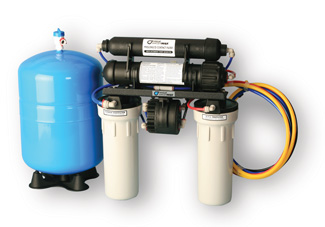What Is Reverse Osmosis?
 The real flavor of water refreshes and satisfies. But today, enjoying a drink of water may not be as simple as filling your glass from the tap. Even when treated by an approved municipal water system, the goodness of water is often marred by minerals, organic matter or chlorine.
The real flavor of water refreshes and satisfies. But today, enjoying a drink of water may not be as simple as filling your glass from the tap. Even when treated by an approved municipal water system, the goodness of water is often marred by minerals, organic matter or chlorine.
Reverse Osmosis is a filtration process used for water. It works by using pressure to force a solution through a membrane, retaining the solute (dissolved solids) on one side and allowing the treated solvent (water) to pass to the other side.
The membranes used for reverse osmosis water systems have a dense barrier designed to allow only water to pass through while preventing the passage of solutes (such as salt ions). This process requires that a high pressure be exerted on the high concentration side of the membrane.
Features For Quality Drinking Water:
- Designed for maximum water cleaning efficiency with no operating costs except for periodic replacement of disposable filters
- Efficient on water pressure as low as 30 psi
- Non-electric operation
- Up to 33% more tank pressure for increase flow and volume
- Fills holding tank up to 5 times faster than other systems
- Membrane technology consistently reduces up to 99% of total dissolved solids (TDS)
- Includes a long-reach dispensing spigot with air gap
- Completely pre-tested with a 25-year limited warranty
Water Contaminant Reduction:
The H3500 reverse osmosis water softener also reduces contaminants found in a household's water supply such as:
Arsenic (Pentavalent) <=50 ppb, Barium, Cadmium, Cyst, Fluoride, Chromium (Hexavalent), Lead, TDS, Chromium (Trivalent), Nitrate/Nitrite, Radium 226/228and Selenium

| Attachment | Size |
|---|---|
| Reverse Osmosis Owners Manual.pdf | 1.86 MB |
